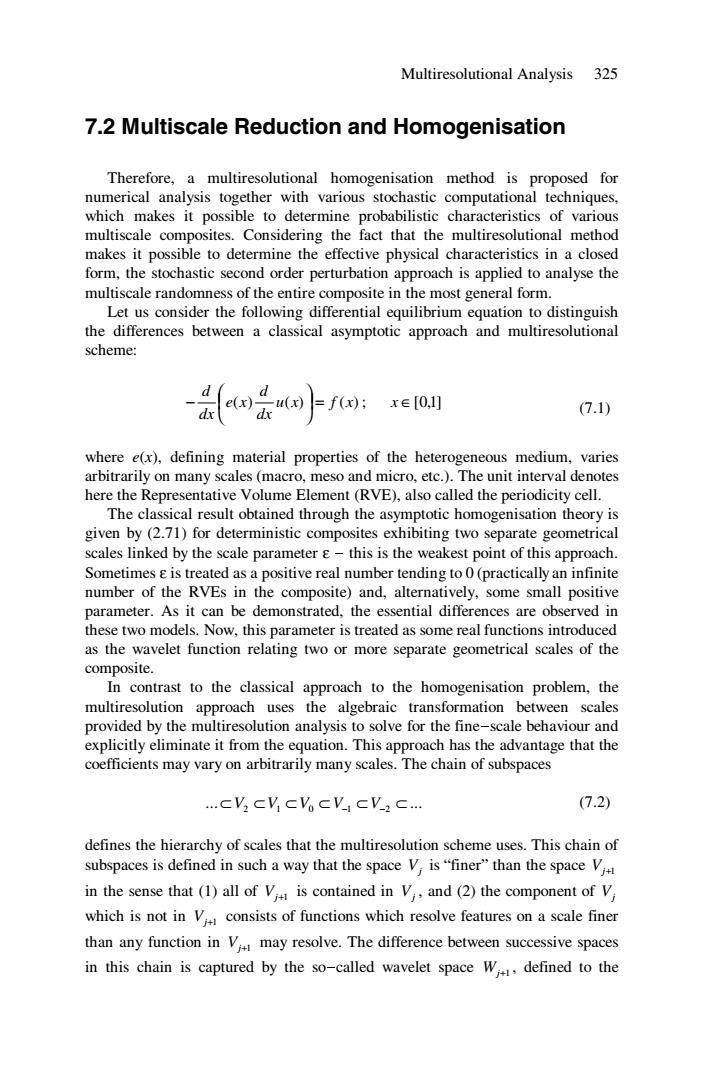正在加载图片...

Multiresolutional Analysis 325 7.2 Multiscale Reduction and Homogenisation Therefore,a multiresolutional homogenisation method is proposed for numerical analysis together with various stochastic computational techniques, which makes it possible to determine probabilistic characteristics of various multiscale composites.Considering the fact that the multiresolutional method makes it possible to determine the effective physical characteristics in a closed form,the stochastic second order perturbation approach is applied to analyse the multiscale randomness of the entire composite in the most general form. Let us consider the following differential equilibrium equation to distinguish the differences between a classical asymptotic approach and multiresolutional scheme: =fx) x∈0,] (7.1) where e(x),defining material properties of the heterogeneous medium,varies arbitrarily on many scales (macro,meso and micro,etc.).The unit interval denotes here the Representative Volume Element(RVE),also called the periodicity cell. The classical result obtained through the asymptotic homogenisation theory is given by (2.71)for deterministic composites exhibiting two separate geometrical scales linked by the scale parameter e-this is the weakest point of this approach. Sometimes e is treated as a positive real number tending to 0(practically an infinite number of the RVEs in the composite)and,alternatively,some small positive parameter.As it can be demonstrated,the essential differences are observed in these two models.Now,this parameter is treated as some real functions introduced as the wavelet function relating two or more separate geometrical scales of the composite. In contrast to the classical approach to the homogenisation problem,the multiresolution approach uses the algebraic transformation between scales provided by the multiresolution analysis to solve for the fine-scale behaviour and explicitly eliminate it from the equation.This approach has the advantage that the coefficients may vary on arbitrarily many scales.The chain of subspaces ...cVCVCVCVCVC... (7.2) defines the hierarchy of scales that the multiresolution scheme uses.This chain of subspaces is defined in such a way that the space V is"finer"than the space V in the sense that (1)all of V is contained in V,,and(2)the component of V which is not in V consists of functions which resolve features on a scale finer than any function in V may resolve.The difference between successive spaces in this chain is captured by the so-called wavelet space W,defined to theMultiresolutional Analysis 325 7.2 Multiscale Reduction and Homogenisation Therefore, a multiresolutional homogenisation method is proposed for numerical analysis together with various stochastic computational techniques, which makes it possible to determine probabilistic characteristics of various multiscale composites. Considering the fact that the multiresolutional method makes it possible to determine the effective physical characteristics in a closed form, the stochastic second order perturbation approach is applied to analyse the multiscale randomness of the entire composite in the most general form. Let us consider the following differential equilibrium equation to distinguish the differences between a classical asymptotic approach and multiresolutional scheme: ( ) u(x) f (x) dx d e x dx d ⎟ = ⎠ ⎞ ⎜ ⎝ ⎛ − ; ] x ∈[0,1 (7.1) where e(x), defining material properties of the heterogeneous medium, varies arbitrarily on many scales (macro, meso and micro, etc.). The unit interval denotes here the Representative Volume Element (RVE), also called the periodicity cell. The classical result obtained through the asymptotic homogenisation theory is given by (2.71) for deterministic composites exhibiting two separate geometrical scales linked by the scale parameter ε - this is the weakest point of this approach. Sometimes ε is treated as a positive real number tending to 0 (practically an infinite number of the RVEs in the composite) and, alternatively, some small positive parameter. As it can be demonstrated, the essential differences are observed in these two models. Now, this parameter is treated as some real functions introduced as the wavelet function relating two or more separate geometrical scales of the composite. In contrast to the classical approach to the homogenisation problem, the multiresolution approach uses the algebraic transformation between scales provided by the multiresolution analysis to solve for the fine-scale behaviour and explicitly eliminate it from the equation. This approach has the advantage that the coefficients may vary on arbitrarily many scales. The chain of subspaces ... ... ⊂ V2 ⊂V1 ⊂V0 ⊂ V−1 ⊂ V−2 ⊂ (7.2) defines the hierarchy of scales that the multiresolution scheme uses. This chain of subspaces is defined in such a way that the space Vj is “finer” than the space Vj+1 in the sense that (1) all of Vj+1 is contained in Vj , and (2) the component of Vj which is not in Vj+1 consists of functions which resolve features on a scale finer than any function in Vj+1 may resolve. The difference between successive spaces in this chain is captured by the so-called wavelet space Wj+1 , defined to the